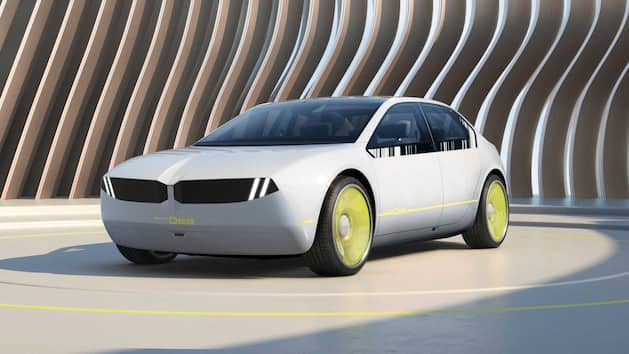The BMW iVision Dee should enable new digital experiences inside and outside the car. The futuristic-looking study of a mid-size sedan will be shown at the electronics trade fair CES 2023. The iVision Dee is a further step on the way to the new class, according to BMW boss Oliver Zipse.
Apparently, the car anticipates elements of the new class that will be launched in 2025. According to BMW managers, this new electric platform will first be launched as a mid-range sedan and SUV.
The very angular-looking study has little in common with today’s BMWs, it is more reminiscent of the Lancia Delta. Visually, the car has a notchback, but the renderings do not show whether a small trunk lid is installed, as in today’s BMW 3 Series, or a large flap, as in the BMW i4.
The traditional double kidney and the headlights appear only when the drive is switched on. Instead of round headlights, there is a new two-stripe look.
But first of all, BMW is not primarily concerned with the exterior optics with the iVision Dee, but with the electronics, as it should be at the CES. Dee stands for Digital Emotional Experience, so the promised electronic functions should arouse emotions. According to BMW, they go far beyond today’s voice controls and assistance systems. BMW promises a head-up display that extends across the entire width of the windshield. It should be available in the new class from 2025, writes BMW.
The study looks far into the future and shows the outstanding importance of digitization in future vehicle generations – hardware and software would merge here. “He who masters this integration of the digital living environments of his customers into the vehicle on all levels, masters the future of automotive engineering,” adds Frank Weber, Board Member for Development.
While previous design studies (especially at CES) were mostly autonomous vehicles, the iVision Dee has a normal steering wheel inside. However, most other controls are missing – physical buttons no longer appear to exist on the dashboard, nor do conventional displays.
The Mixed Reality Slider, a virtual slider on the dashboard, is primarily used for operation. This is apparently (like the head-up display) realized by projection technology:
“The BMW iVision Dee visualizes how an extended head-up display can also be used for the display operating concept in the future.” (BMW)
With the slider you can determine which content the head-up display should show. The lowest of the five digitization levels is referred to as “analogue”, followed by information relevant to the driver, content of the communication system (probably telephony, e-mail and the like) and an augmented reality projection, and finally “entry into virtual worlds”. At the same time, the outside world can be faded out step by step using dimmable panes.
“As early as 2025, the series version of the BMW head-up display will be used across the entire width of the windscreen in the models of the new class.” (BMW)
If we understand the indications from BMW correctly, in 2025 only the huge head-up display will go into series production, but the projected elements on the dashboard will probably not.
In addition to the virtual slider, there are also touch surfaces on the vertical spoke of the steering wheel, which only become visible when you approach it. This is used to configure and control the content on the windscreen. In general, BMW follows the motto “hands on the wheel, eyes on the road”.
BMW CFO Nicolas Peter had already announced a study on the new class in November. A lot is already known about the new platform. As mentioned, it makes its debut in the middle class. The mid-range sedan could be given the vacant name i3, and the SUV may inherit the iX3.
Both models are fitted with cylindrical 4895 and 48120 battery cells, with the 95 mm high version being used in the sedan and the taller 48120 cells being installed in the SUV.
The battery sizes should be between 75 and 150 kWh, so far there is no information on the range. But BMW seems to be putting the emphasis more on fast charging: With the 800-volt system of the new class, you should be able to recharge electricity for 600 km in 30 minutes – that would even make 1,200 km possible with a relatively short charging stop during the lunch break.
Otherwise, in addition to conventional rear and all-wheel drive with one or two electric motors, four-motor layouts are also possible, as BMW M is already testing. The drive power can be between 200 and 1,000 kW.
This article was written by Stefan Leichsenring
*The post “BMW’s new electric generation shows sharp edges” is published by Motor1.com. Contact the person responsible here.
On our e-mobility portal EFAHRER.com you will find all e-vehicles available on the German market
You can also arrange a test drive for the car of your choice free of charge and thus start e-mobility in an uncomplicated manner.















